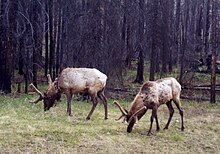Manitoban elk
Appearance
| Manitoban elk | |
|---|---|

| |
| Scientific classification | |
| Domain: | Eukaryota |
| Kingdom: | Animalia |
| Phylum: | Chordata |
| Class: | Mammalia |
| Order: | Artiodactyla |
| Family: | Cervidae |
| Subfamily: | Cervinae |
| Genus: | Cervus |
| Species: | |
| Subspecies: | C. c. manitobensis
|
| Trinomial name | |
| Cervus canadensis manitobensis | |
The Manitoban elk (Cervus canadensis manitobensis) is a subspecies of elk found in the Midwestern United States (specifically North Dakota) and southern regions of the Canadian Prairies (specifically Manitoba, Saskatchewan, and north-central Alberta).[2][3][4] Compared to the Rocky Mountain elk, it is larger in body size, but has smaller antlers. The subspecies was driven into near extinction by 1900, but has recovered since then.
The Manitoban elk's primary predator is the wolf. Because the elk is a non-migratory species, it cannot rely on long-distance migration to reduce the risk of predation, and therefore uses a combination of behavioral patterns, such as aggregation, movement, and vigilance, to avoid predation.[5]
References
- ^ Erxleben, J.C.P. (1777) Anfangsgründe der Naturlehre and Systema regni animalis.
- ^ http://www.dto.com/hunting/speciesProfile/152
- ^ http://www.wideopenspaces.com/species-elk-north-america-can-hunt/
- ^ http://www.gothunts.com/species-of-elk/
- ^ Vander Wal, Eric; Paquet, Paul C.; Andrés, José A. (March 2012). "Influence of landscape and social interactions on transmission of disease in a social cervid". Molecular Ecology. 21 (5): 1271–1282. doi:10.1111/j.1365-294X.2011.05431.x. ISSN 1365-294X. PMID 22289112.
See also
